How the hell do you get more leads? It’s a multi-million dollar question. And despite all the fancy new tools marketers have at their disposal to measure and optimize, there is still never one clear-cut answer. Lucky for us one of the very best in the business, Meagen Eisenberg, CMO at MongoDB and former VP Demand Gen at DocuSign, shares her playbook for optimizing the funnel at every stage and converting leads into real, paying customers.
Some of the biggest takeaways from her talk include how marketing can provide support to sales to attract new customers, the importance of optimizing your web properties to reach more people, and the many ways in which you can generate leads on a tight budget.
There are not that many people who are as good at this as Meagen. If you need more leads (and who doesn’t?) you don’t want to miss this one. You can view Meagen’s slides here.
If you want to see more sessions from 2016, we’re releasing a new one each week. Subscribe here to be notified. And be sure to grab your tickets to the 2017 Annual NOW.
TRANSCRIPT
Emmanuelle Skala: I have the pleasure to introduce our second CMO speaker of the day, Meagen Eisenberg. Many of you know Meagen already. She’s currently the CMO at MongoDB, another open source company.
She has 20 years in high tech marketing. She was named The Top 50 Most Retweeted Person by “Adweek.” She is a huge influencer for many brands. She’s won lots of awards, as well, in the Bay Area.
She was also recently Vice President of Marketing at DocuSign. She is from the California area. What Meagen’s going to talk about is the thing that we all want to know is, “How the hell do you get more leads?”
I’d like to welcome Meagen to the stage.
[applause]
Meagen Eisenberg: Thank you.
Emmanuelle: Be careful, because this is a little…
Meagen: Yes, very nice. Thank you. I am excited to be here. Thank you for the nice introduction.
I definitely think this is near and dear to everyone as you’re trying to grow your business, as you’re working with your sales team. A lot of people fixate on leads, and certainly what we care about are the quality leads.
When I look back, even at DocuSign and where we went when I joined, we had about a million in our marketing database which was Eloqua. When I left, we had about 23 million over three and a half years.
Now, I’ve joined MongoDB and the open source world as well. I’ve been there about 11 months. I came in, we had about a million leads, and we’ve doubled that. We’re a little over 1.8 million in our database. I think fundamentally, these areas that I’m going to cover can apply at any stage of your company.
I do advise for about half a dozen startups that are trying to figure this out as well. This is what I’m going to cover in the next few minutes.
Before I jump into the people process technology, I think for those of you who are marketers, and for those of you who are not, there is definitely a mix that you need at a company as you grow, that you’re going to be building out with your marketing team in order to cover the entire funnel.
There are a mix of things that you’re running at the front of the funnel which are giving you air cover. People are first being introduced to you, and then as leads come in, you’ve got several inbound things that you’re doing to educate them and to accelerate the funnel so they eventually become customers.
Once they’re customers, you need those customers advocating for you to get more leads in the funnel. Influitive certainly is one of the tools that we use at MongoDB, but it’s true, it’s that social proof that everyone needs.
The number one thing over and over again is people talking to other people. How do you get more of out there so you get more people in? I always, when talking to the marketing team, realize that there are many different things we need to do.
A lot of it’s online now, but people digest information and learn about things in different channels, and so understanding all of those channels.
If I dive right into people, I always get asked, “Who should I hire first? Who did you hire first? What do you need on your team to be successful?”
For me, the last three companies, I think the three key hires are, one, product marketing. You need someone who gets the customer, gets the content they need to digest, and can write.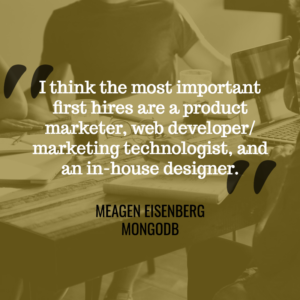
You need a web developer/marketing technologist, because so much of this is online, people are digesting before they even talk to sales. You need someone that can help you get it out there online.
The third is really creative. If I look at DocuSign and MongoDB, I was lucky enough, I had great product marketers. I hired a technologist web developer right away. I started day one at MongoDB with that person starting with me, and then quickly after that, I hired a creative person.
If you need to get anything out the door, the worst thing is to have to go to an agency, or not have the talent in-house. It just slows you down, so I am a big advocate for having someone who can create the assets you need to go online.
Certainly, part of getting leads is understanding who your sales team actually wants to talk to. When I joined MongoDB, we had tons of developers. We love developers, and we want more and more of them, but sales wants to talk to people who have budgets and are making and taking our product into production. They actually want to talk to Ops and DB admins.
We had to really think about, “How do we pillar up from the developer?” We had to understand that in marketing, who they wanted to talk to, otherwise we would keep delivering developers and they would keep saying, “These aren’t the leads that we want.” It’s crucial that you’re partnering with your sales team, and you truly understand who they want to talk to to make them successful.
Then, of course, we know content’s important. Back to first hire of product marketing is that there’s also others that can help you create content, thought leaders in the space, analysts, of course, if you have analysts or Magic Quadrant. What are you doing to brief those analysts, make sure you’re part of those conversations they’re having, that they know your product, depending on what space you’re in.
Having just come from an all day SaaS meeting with Gartner that started at 6:00 AM, I definitely know the importance of our analysts, and certainly partners who may help get the word out there, as well, that you go to market with. Make sure you have the right people involved at your company.
I will quickly jump to technology, because I think the largest lift you’re going to see is through your website. A majority of leads are coming in through your web properties. Certainly if, I’ve heard 67 percent. I think it’s over 90 percent for us at MongoDB, and was similar at DocuSign.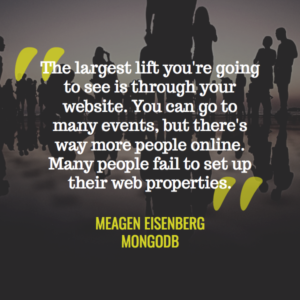
You can go to many events, but there’s way more people online. I think people fail to set their web properties up. Often they outsource who develops and does their websites, so they can’t move very fast. They don’t have a very prominent call to action when you hit the home page.
People want to know who you are, but then you need to quickly get them into your funnel. How are you optimizing? How you capture people is really important on this. I can tell you, with not having a lot of budget, joining, we had about 30,000 leads my first quarter, and we quickly jumped to 60,000 the second quarter, 80,000 the third, just by focusing on our web property, and making sure we had the content on there people wanted to fill a form out for.
Make sure you’re gating content appropriately. Don’t be gating customer case studies, because you want those in front of everyone, social proof, back to that one. You also don’t want to gate product briefs or anything like that.
It’s hard to get people to read that stuff, but things of value like thought leadership, how-to guides, architectural guides, analyst papers, those are all great things of value. Of course, people realize that they have to register for webinars, so that’s certainly part of your mix, and then serving that up.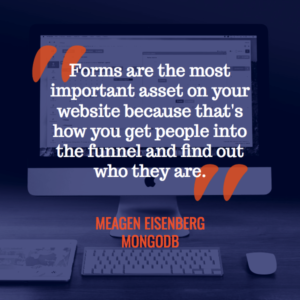
Forms. I think this is your most important asset, actually, [laughs] on your website, because that’s how you get people into the funnel, and find out who they are. People, I’ve seen only ask for 1 thing, email address, all the way to asking for 13 things.
I think five is about right. Why I say that is that, if you want to do the appropriate follow up, and really tailor your message to the persona that’s coming, you need to know a few things, and it’s mostly personal information you need to have.
One, you want to be able to address them, so a name.
Two, a title. I would argue most companies have different persona coming in. If I talk to someone that’s an architect, like they’re a developer, I’m not going to get that personal message to them. Someone that’s a C level audience needs very different content than someone who is not. If I don’t have title, my follow up is not as effective. My sales team is not as effective.
Then, of course, you need an email or phone number, a way to contact them. Usually, sales doesn’t want to follow up if they only have email address, so phone number becomes important.
I’d say five or six fields, and then you should be using technology on the backend, to get the rest of the information. If you are asking for location information, you need to stop. You can get that with Java code, IP address. If you’re asking for location information, take that off, because the more questions you ask, the less people are going to fill it out.
Optimize your forms, and buy the technologies that will append that information later, or on the back end, or pull the code. That other technologies, like industry, company size, location, all of that you can get on the back end. You will see immediately jump, if you do this.
For those of you who are only asking for email address, I would say you’re rendering your sales team. First of all, it’s not as useful for them. As marketers, you can’t tell tailor or nurture them as well. Yes, you have progressive profiling, and you can try to get them back, but they may not come back, and now you have a bunch of email addresses that you’ve got to do a lot more with.
I do think people, if the asset’s compelling enough, will give you just enough information for that. I’ve seen this on trial forms, too.
A little more on technology, certainly you need a marketing database to play with. Salesforce is not a marketing database. That is a place you only want to send those that sales should be talking to and working with.
You need a marketing database where you can warm up folks. You don’t want to be buying lists, and putting them into Salesforce. That is when your sales team is going to say, “You’re giving me junk. These people are cold,” and they’re right. That information’s inaccurate, and you’re just creating a bunch of noise and junk in Salesforce.
You need a marketing database. Sure, you can buy list buys, but you’re not syncing them over to Salesforce unless they engage with you. Unless they click through, fill out something, do something that says it’s a live body and there’s some interest, then you can sync them over and score them.
The targeting and personalization, if you have the right information, we use Eloqua, and we use Demand Base and InsideView, actually, for appending information and personalization, but it just gives a much better experience when they’re on our website, and when we follow up.
We do use Demand Base to change our content. We sell an offering, we have an e-commerce cloud product, where you can sign up without ever talking to sales to monitor MongoDB. We have enterprise products where multi-year, multiple servers, you’re buying this license that’s giving you security, and all the other things with it that you do talk to a sales rep for.
Depending on the size of your business, those offerings are very different. If you’re a smaller business, you tend to go to Cloud Manager. If you’re a larger one, you’re talking to our enterprise team. When you hit our website, if I know immediately that you’re a small business, I’m going to serve you the offer of Cloud Manager. If I know you’re enterprise, I serve you our enterprise offering.
We do use these technologies to change our call to action in real time. Other things is we can load our customer list, and offer them different things to expand the footprint with them.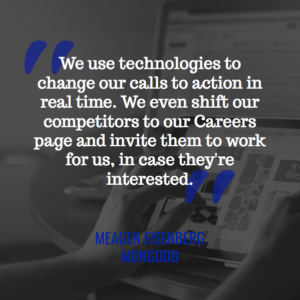
Even our competitors, we shift them to our Careers page. We can load them up, and invite them to come work for us, if they’re interested.
[laughter]
Meagen: There’s these cool technologies out there, that are certainly helping us capture the traffic that’s on your site. That’s the biggest lift you’re going to get, and I would challenge you to go, “Look, how many people do you capture now, that hit your site, that if you had optimized it, how many more leads you would get from that?”
Then, of course, making sure you have some sort of CRM system. Most of us do have one of these, but if you’ve got Salesforce, which I’m most familiar with, you should be setting up, as marketers, the Campaigns module.
You should be tracking everything that comes in, because you want to know what’s working with your budget. When you analyze that, and you go to spend the next quarter, you spend on what’s actually driving leads that convert. Not just volume, but is actually getting things that convert to the opportunity for your sales team.
Campaigns tracking in Salesforce is what lets you do that, but if you only market things as marketing-generated, but not, “This was a…very specific webinar, very specific content paid search,” you’re not going to know how to shift your budget around that you’re testing.
The other thing I do, when I first join a company…Right out of college I joined Cisco Systems as a IT engineer, and I focused on manufacturing IT in that division. [laughs] I got APICS certified, and it was all about the manufacturing floor, and bottlenecks, and things going through and not going through. It really applies to lead flow, and the handoff between marketing and sales.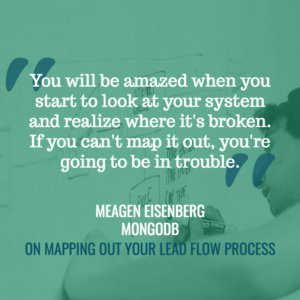
You will be amazed, when you start to look at your system, where it’s broken. This is just a sample, but if you can’t map it out, you’re going to be in trouble. You want to have that conversation with your sales Ops person, your marketing Ops person, and do simple checks.
We passed 10,000 leads over, Salesforce actually captured 10,000. 10,000 was assigned to sales, if they were supposed to be, or the 3,000 that were qualified. How does the sales team receive it? What’s the APICS logic that assigns and routes these leads?
Most people do it by territory, and then round robin within the territory. What rules do you have set up? Sit down with your sales rep, your STR. What’s the report you’re running to look at your leads?
I will tell you at MongoDB, what I learned is that when they sat down, they were using a filter that we no longer use, and they were only seeing 10 percent of the leads we were sending over. “I only get 50 leads.”
When I look at the report, it was like, “You’re not including your area, and you’re excluding X, Y and Z.” As soon as we rewrote the reports for them, all of a sudden, they have 1,000.
You’ll be surprised, these Salesforce instances have evolved, and you’ve had turnover. The knowledge that was there, that originally set up is gone, and nobody even knows how they were set up in the past, or why.
When you’re at a company, or a startup, make sure that you’re setting this up and understand it, because you will see an increase in your leads, just by fixing this process. Also, it’s the feedback loop. It’s how sales tells you if your leads are qualified or not, how they marked the leads, or even if they’re working the leads.
This is a very important process, I’ve found, for my success and my partnering with sales is mapping this out, and having a very clear understanding of the flow.
Of course, I’m a fan of SiriusDecisions, and their waterfall. I think most companies, when you talk to sales, what they care about is their pipeline. What pipeline means to them is, “Do I have opportunities in Salesforce, with dollars against it, and is it four or five x what I need to close?”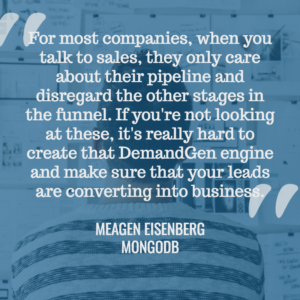
They don’t think about any of the other stages in the funnel, and why you care about those other stages is usually there’s marketing, there’s a qualification team, and then there’s the sales rep. There’s problems throughout that funnel and those handoffs that you want to smooth out and uncover.
If you’re not looking at the different stages, we actually have one more stage called SQO that sits after the SQL, at MongoDB. If you’re not looking at these, it’s really hard to make that demand gen engine and make sure that the leads you do get are converting into business.
I would not just focus on what Ops dollars are there, but all the processes before that. I think a lot of it sits in the qualification team, whether your sales team’s getting anything or not.
Also lead scoring. This is another tool to make sure the leads you’re sending over are actually the quality your reps need, and it’s important that sales and marketing build this together, and that you agree, and you really set down, “Is it a specific industry? Is it a specific size of business? Is it a specific form that they filled out? Do you care more about people who signed up for a trial over someone who stopped by the event booth?” Probably.
“Someone who downloaded enterprise worksheet over someone who was crawling around the careers page.” It matters what they look at, it matters what they digest, and it matters who they are. If it says student or consultant, and that’s not who you sell to, that’s probably a very low scoring lead.If it says VP of IT, or IT director, and that’s who you target, then you’re going to score those higher.
If you have large volumes of leads, you need this to make your sales team more efficient, so they work the best. Even if you have low volume of leads, this is going to help you truly get who your sales team wants to talk to, and better score them, understand what converts, and then improve this.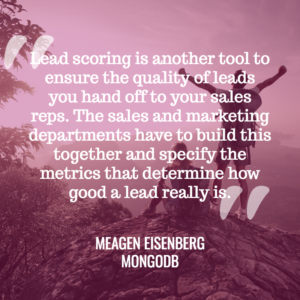
Campaigns, I talked about this a little bit before. If you’re not using this, you need to set it up, and it needs to have a taxonomy. I have been with companies where everything that comes in the marketing source is just marketing. That’s not useful when you’re trying to figure out what actually converts.
“Do I need to do more webinars around NoSQL and what it is, or do I need to do more webinars around security?” There’s certain ones that do better than others, and you need to not only mark them as that type, but then the individual campaign, and then track it all the way through.
Of course, there’s always the discussion of who sourced it. If you don’t have campaign information on it, it’s hard to answer that question in your instance, “Who actually is sourcing the deals that sales are closing?” This will help you get to that answer. Having a naming convention will definitely help you do better reporting, and classify things, and find things.
I’m a big fan of nurturing, and why, there’s several reasons here, but I do think it aligns the buyer, as they come in, with your sales team.
I’ve talked with some companies that are afraid to nurture the lead once it gets handed off to sales. I would say you nurture everyone, and you continue, because the sales follow up process is inconsistent. Often, they’re not getting all the content that person needs to make that decision, and you’re helping them.
It’s very obvious, when the marketing team sends nurture emails out, and it’s coming from a company, versus a sales rep sending a personal email. We have seen acceleration of deals, because at DocuSign, you wanted to know if it’s secure, all my IPs there, so we make sure they get the security information.
It was important to know that it was legal. Yes, electronic signature is legal, so make sure that at some point in the nurture process, they have that information. Then, “Who else is using it?” Giving them case studies by automating that nurture.
At DocuSign we had over a hundred different nurture programs, based on your persona, based on your industry, if you were in a trial, what type of trial, what type of customer, and then in different languages.
At MongoDB, we’re a little bit over 20 nurture programs based on persona right now, based on trial, and then region, and what type of customer you are. We definitely see it accelerating our deals, and having an influence on our deals. That’s educating people as they come.
The worst thing is, someone fills out a form, and you batch them an email to a webinar. Six weeks later, sales sends them an email, or calls three times, and it just stops. They didn’t pick up, and they go on to the next lead. “This is a crap lead.”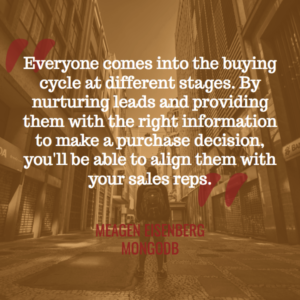
Everyone comes in, also, at different stages of when they’re ready to buy. You’re getting them all on the same page by making sure they have the right information. I would build this out, and what you’re seeing across the top is the buyer’s journey, and then the drip of content.
There’s other things you can set up, web triggered content. Let’s say they go to your trial page, you know who they are because they filled a form out somewhere else, but they don’t sign up for the trial.
It’s just like Pottery Barn. I go look at a table, and the next four hours they go, “Hey, I saw you looking at our table. Are you sure you don’t want to buy?” I may go back and buy. It’s the same thing. “I was looking at the trial, but someone walked by my desk. I didn’t sign up,” and I go back and do it.
Or, we have someone go into our docs. There’s a topic they’re interested in, we send them information. Maybe they’re looking at some architecture stuff, we send them a guide. It’s understanding what they’re looking at, and then delivering that content to make sure you’re top of mind.
One more point on this, if you’ve lost a deal, if your sales rep marks lost a competitor, and you’re one of those renewal type businesses, you definitely want to nurture those type of people 5 months later, 11 months later, “Hey, are you happy with the decision you made?”
People select MongoDB because of these three top areas of differentiation. We’re happy to talk with you if that other vendor you went with didn’t solve your need, or you’re not happy. That’s not something your rep’s going to remember to do 5 months out and 11 months out, they’re just going to move on to the next deal. You can increase your pipeline that way.
Measuring success. How do you do that? In the world of email marketing, it’s not just opens. Quantity is great. “Are they engaging?” Great, but more importantly, is it actually influencing deals? That white paper, was that something someone at that company digested, or not?
You want to make sure that, one, you start to see your deal cycle shrink, but the stuff is actually influencing the deal, through the campaign, you can run campaign influence reports to see everything that touched that particular deal, after it was created and then closed.
The other thing that you can do is you can do blind form submits. If people go to your blog, and they’ve filled out a form before, you can tie that person to the campaign for the blog, if they’ve downloaded content, or if you send them an email.
If you’re emailing them, you already know who they are. You don’t have to have them fill out a form, but you should still track if they click through and digest that information.
I do always get, with startups, “What I only have 10K. I don’t have a lot of money, I can’t afford to buy all that technology. What can I do?” A lot of it is testing. You’ve got a small amount, test, get results, and do more of it.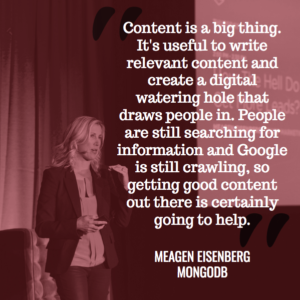
Content is a big thing. If you can write relevant content and create some sort of digital watering hole where it draws people in, that’s time, clearly, but that’s content. People are still searching, and they’re looking for information, and Google is still crawling, so getting good content out there is certainly going to help.
I think social media, and influencers, earlier we were talking about having advisors, or people that are in your particular space that everyone else looks to, getting them to tweet, having them educated on your product, having them speak on a webinar, draws people in.
At DocuSign, most of our large webinars were because we had someone who was a major influencer in that space talking, or we partnered with someone who was bigger than us, that had a better name brand, and their logo brought people in, because we both invited folks to that webinar.
Partnering with folks, doing webinars, it’s time consuming, but you can get a draw. People that attend webinars, that’s a high level of interest, certainly. Blogs, of course, are great. I mentioned webinars.
There’s always email marketing. I think people still do, if you’re targeted enough, they do open that. Accuracy of lists is tough, but that is still there. Certainly, any type of referral program. Box, DropBox, these companies did a great job of getting, finding a way where they incented you. You got more gigabytes of storage, or whatever the incentive is, for your company, can you make it where people are referring you? Social proof, all of that is valuable.
Horse trading. if you don’t have money, but you have something of value you can offer to someone else, trade. I traded technology at DocuSign, to get someone to write a white paper, or to be on a webinar. If you can trade your technology with someone who will trade something back, I think that’s all good will, and just it’s your budget to go a lot further.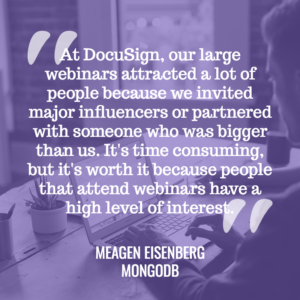
I think when you look at all of these things, if one, you hire the right people, you know how to work within a company, as one team, you work with your sales team, you’re working in educating the analyst, you have the right technology in place, so you can make better decisions off of the data you’re collecting.
Then you put the right processes in place, you’re going to be a lot more successful at getting leads, and capturing those leads, and then getting them to actually buy, because who really cares how many leads you have if they’re not buying?
Figuring out how to get them to convert, and having marketing efficiencies, even if you have a small team. “Can you automate? Can you use these platforms to automate the nurturing, and the email batches?”
Can you get your website to work for you? Make sure you’re capturing that traffic that’s there. Make sure you’re improving those conversion rates, and A/B testing, anything you can do A/B test, to get it through.
My success, I think, is really aligned with being aligned with the sales organization, being aligned with your CRO, your head of sales, truly listening to your sales team, partnering with them, seeing them as an internal customer, because you don’t want to fight with them. [laughs]
If they’re not going to work the leads you’re sending, there’s no point, so hear what they need, and then deliver that. Show them you’re delivering it, and agree on how you’re going to measure that.
Of course, if you want to be valued at an executive level, know your numbers. Know what’s working. Small or large budget, be able to show what’s working, and be transparent when it’s not, so that they trust you and what you’re telling them.
Marketers tend to market internally, and say, “Everything’s great, everything’s great, we’re doing great,” but if you’re not balanced in how you talk about your business, people aren’t going to believe you when you are doing great, so share the failures, as well.
That’s my talk for today. I’m happy to answer any questions.
Emmanuelle: That was great. That was amazing, Meagen. Thank you.
[applause]
Emmanuelle: I have a feeling there’s going to be a ton of questions out there. I’m going to ask one to get it kicked off. I see two right here in the front, so if we can get the mics to go to these folks in the front.
Do you have an SLA? You talked about the partnership with sales and marketing. Do you have an SLA with sales? Is that a pipeline number, a dollar number, is it an MQL number? What is your SLA with sales, and how do you figure out what it is that you both agree on?
Meagen: At DocuSign, our SLA depended on the score. If it was a A, and it was a business day, it was within eight hours. If it was a B, it was within 16 hours. We were less concerned about the lower scored ones. At MongoDB, we’re not quite there yet on the SLA.
I do recommend having that agreement on follow up. While we don’t have the SLA in place, we have a dashboard that goes out every week to all of the sales leaders, showing all of the MQLs, being the qualified leads that have never been opened by the sales team, and then we rank each of the reps that are supposed to be working them, and show who’s working the leads, and who’s not.
People love to compete. People don’t like to be on the bottom of that. The sales leaders have a hard time complaining about not getting leads if they see a dashboard that shows a bunch that haven’t been worked yet. [laughs] Having the dashboards, I think, helps a lot.
Emmanuelle: Is there an SLA the other way? Is there a commitment from marketing to deliver a certain…?
Meagen: There is. At the beginning of every year, I did this about 11 months ago. I look at the revenue targets. I look at our average deal size across the different businesses. By looking at the targets, the average deal size, I used industry benchmark conversion rates on that funnel I showed, to back all the way into how many leads, MQLs, SALs, SQLs and deals marketing needed to deliver and source to make it.
We just did this exercise this year, but I was able to use our actual conversion rates, based on last year. I spent about an hour and a half with our CRO, explaining the model, how it’s set up, how we’re going to agree to source 50 percent of the business, based on these conversion rates, by these definitions, and that’s our target.
Now, what’s changed, last year I was measured on MQLs. This year, I got suckered into SALs, which is further along, but I think if it’s a partnership, if you don’t hit your revenue targets, the CMO goes first, the head of sales goes next, and then the CEO, so I’m incented to make sure we make our target all the way across.
Emmanuelle: [laughs] I think I disagree. I think VP of sales goes first. There’s some questions here, where is the mic?
Audience Member: Right here. There’s another one right in front of you. Look straight ahead. I’m right here.
Meagen: Sorry, hi.
Audience Member: So you’re blind. [laughs]
Meagen: I can’t see. The lights, they’re very blinding.
Audience Member: Fair enough. Thanks so much, a super comprehensive session. I have so many questions now, that you said those last two things.
In your opinion, how much qualification should SDRs or account reps be doing at the SAL stage? This is something that we’re always working on, with our MQLs. It’s exceptionally challenging.
Meagen: If you’ve got really good scoring models, the ones that score higher, if they truly are ones that you should be talking to, you should do multiple. You should do more than three.
Typically, there’ll be a rule. “I called three times, I emailed three times, I moved on.” If it’s truly an A, or if you’re using the predictive modeling out there, you should call 8, 9, 10 times, until you get a hold of that particular lead, if they’re truly a target you want to buy into.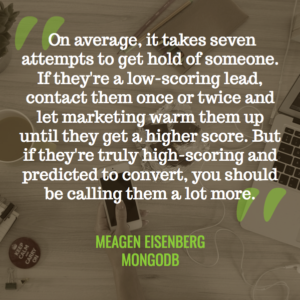
I’ve seen stats, I think it’s on insidesales.com. On average, it takes seven attempts to get hold of someone. I would say, if they’re a low scoring lead, once, twice, and let marketing keep warming them up until they get a higher score, but if they’re truly high scoring and predicted to convert, you should be calling them more.
Emmanuelle: Yep, right there.
Audience Member: How would you suggest marrying together the idea of account-based marketing, account-based sales, and those types of metrics and processes into the traditional, demand gen waterfall module that you’ve been explaining?
Meagen: As far as marrying them, it’s usually account based marketing, I have seen as more for your enterprise sales. We have enterprise, a corporate team, and e-commerce. With enterprise, we do take their named accounts. It tends not to be sourcing, as much as filling out engagement within that particular count.
I use a very different mix of tactics. It’s more pipeline acceleration, webinars or dinners. It’s direct mail or door openers, where you’re actually getting in front of it. It’s sitting down, and agreeing who they want to talk to, and then go targeting. It’s social selling into those accounts.
It’s certainly using technologies like DemandBase that will allow you to, as those accounts come to your site, charter or personalize it a certain way. Sometimes, it’s creating micro sites for those. There’s a lot. Engagio is just out there, launching. There’s a ton of products that are tackling ABM right now.
As far as measuring, I tend to say the funnel is still the same. You may not be sourcing, but you’re certainly influencing or adding more to that particular account. It might not be the first lead, but you’re adding 5, 10 different people from the same account, and you’re monitoring them through. You’re still scoring them, and making sure they get routed to the right sales team for follow up.
Emmanuelle: We have time for one more question.
Meagen: Also, sourcing for enterprise is usually a lower percentage versus if you’re supporting corporate. You’re going to source more of their business. A lot of times, the enterprise folks should be elephant hunters, have a good Rolodex, and you’re helping them have a better relationship with that account.
Emmanuelle: One last question?
Meagen: All right.
Emmanuelle: All right. Thank you, Meagen. That was amazing, really appreciate it.
[applause]
See Meagen’s slides here.
